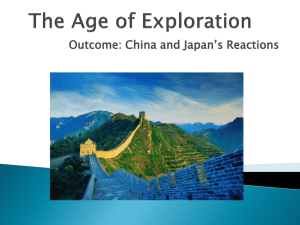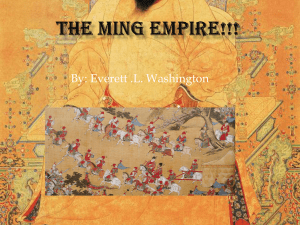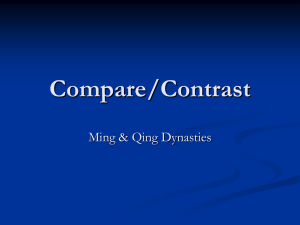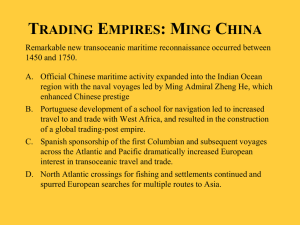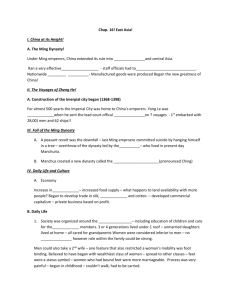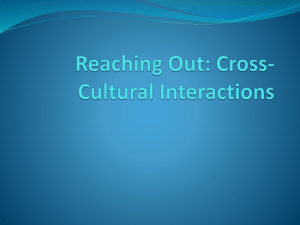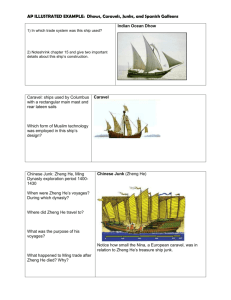China in the Middle Ages
advertisement
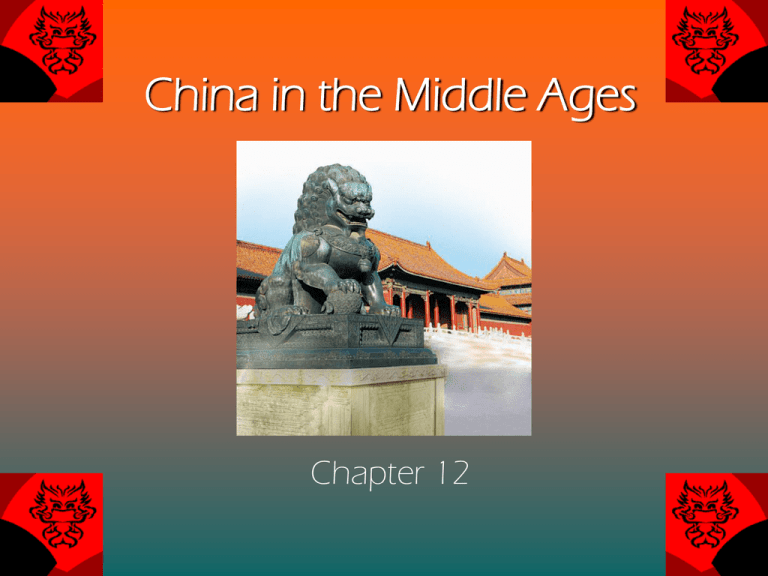
China in the Middle Ages Chapter 12 Section 4 The Ming Dynasty China’s Ming rulers strengthened government and brought peace and prosperity . They supported trading voyages to other parts of Asia and to East Africa. Ming Dynasty China 1368–1644 Reading Strategy Complete a chart like this one to show cause and effect links in China’s early trade voyages. Cause Zheng He traveled to parts of Asia and Africa Traded goods and spread culture Merchants in China grew rich Chinese officials did not like the wealth or new ideas The emperor ended the voyages The Rise of Ming After Kublai Khan’s death in 1294, the Yuan dynasty began to lose control. Mongol groups in Mongolia broke away. Chinese groups wanted their own dynasty. Rebellions drove the Mongols out of power. In 1368, Zhu Yuanzhang led a successful rebellion and became emperor of China. The Rise of Ming He renamed himself Hong Wu. He established Nanjing as the capital and founded the Ming dynasty. Hong Wu was a cruel leader who killed many officials for treason, or disloyalty to the government. Yong Le was Hong Wu’s son who became emperor after Hong Wu’s death. The Rise of Ming Yong Le moved the capital to Beijing, where he built an area of palaces and government buildings known as the Imperial City. The Forbidden City was in the center of the Imperial City. Only top officials could enter the Forbidden City. The Rise of Ming The Ming government restored the civil service examinations and occasionally carried out a census, or a count of people, so they could collect taxes accurately. China’s economy grew under the leadership of the early Ming emperors, increasing farming and trade. The Rise of Ming Restored civil service exams Carried out a census Ming Reforms Rebuilt farms and canals Planted new forests & built new roads Imported new types of rice Supported the silk industry & encouraged farmers to grow cotton & weave cloth The Rise of Ming The Ming emperors supported farmers, artisans and merchants. Writers produced novels, or long fictional stories, and Chinese people watched dramas on stage. The Rise of Ming Review How did the Ming rulers support farmers? Ming rulers repaired and expanded the Grand Canal so that goods could be shipped from southern to northern China. They also imported new types of rice that grew faster and encouraged farmers to grow cotton and weave cloth. The Rise of Ming Review What was the Forbidden City? The Forbidden City was the very center of the Imperial City where China’s Emperors lived. China Explores the World Ming emperors built a large fleet of ships to discover areas outside of China. Emperor Yong Le sent the fleet on seven overseas voyages from 1405 to 1431. Zheng He, a Muslim and court official, led these expeditions. He took his fleet of ships to India, Arabia, Asia, and East Africa, where he traded goods with other peoples. China Explores the World China Explores the World China Explores the World Chinese officials complained about the cost of the trips. They disapproved of new ideas brought from the outside world and the growing wealth of merchants involved in trade. The merchants contradicted Confucius’s teaching by placing their loyalty to themselves above that of society. The voyages ended after Zheng He’s death. China Explores the World In 1514, a fleet from Portugal arrived in China. It carried the first Europeans to sail to China, and the first direct contact between China and Europe since Marco Polo. The Portuguese wanted to trade with the Chinese, and they wanted the Chinese to become Christians. China Explores the World The Chinese thought the Europeans were barbarians, or uncivilized people. The Chinese eventually let the Europeans set up a trading post in China, and European ideas were introduced to the Chinese. Jesuit missionaries, a special group of Roman Catholic priests, arrived in China to convince the Chinese to become Christians. China Explores the World The Ming dynasty fell after rulers weakened. The Manchus attacked in northern China and captured Beijing. China Explores the World Review What caused the loss of shipbuilding technology? The Ming emperors stopped the sea voyages Zheng He had authorized. Then they dismantled the boats and forbade any other ships to be built. In time, shipbuilding technology was forgotten. China Explores the World Review What caused the Ming Dynasty to decline and fall? Ming emperors held too much power in their own hands. Ming rulers became weak, and greedy officials took over the country. They taxed the peasants heavily, and the peasants revolted. Law and order disappeared leaving the country open to an attack by the Manchus. Review What was the purpose of the Forbidden City and where was it located? The Forbidden City was home to China’s emperors and was located in Beijing. Review How did the Chinese react to the arrival of Portuguese traders in 1514? The Chinese thought they were barbarians and at first refused to trade with them. Review Why did Emperor Yong Le send Zheng He on his voyages? How did Zheng He’s voyages benefit China? Zheng was sent on voyages to show off China’s power and open trade between China and other countries; benefits to China were that Chinese traders settled in Southeast Asia and India where they traded goods and spread Chinese culture. China’s wealth grew. Review How did Ming rulers make China’s government strong? The Ming rulers restored civil service exams; carried out census to collect taxes; rebuilt farms and canals; planted new forests; built new roads; imported new types of rice; supported the silk industry; and encouraged farmers to start growing cotton. Review What did the Ming rulers accomplish? The Ming rulers made the government strong; made agriculture thrive; advanced Chinese culture; sent a fleet of ships to other lands; and expanded trade. Review disloyalty to the government A. Nanjing B. Portugal C. Zhu Yuanzhang D. Yong Le E. Zheng He F. treason G. census H. novel I. barbarian Review a count of the number of people A. Nanjing B. Portugal C. Zhu Yuanzhang D. Yong Le E. Zheng He F. treason G. census H. novel I. barbarian Review long fictional story A. Nanjing B. Portugal C. Zhu Yuanzhang D. Yong Le E. Zheng He F. treason G. census H. novel I. barbarian Review uncivilized person A. Nanjing B. Portugal C. Zhu Yuanzhang D. Yong Le E. Zheng He F. treason G. census H. novel I. barbarian Review capital of China under the Ming dynasty; this city was located in southern China A. Nanjing B. Portugal C. Zhu Yuanzhang D. Yong Le E. Zheng He F. treason G. census H. novel I. barbarian Review a country in Europe on the Iberian Peninsula that wanted to trade with China in the 1500s; the people from this country also wanted the Chinese to become Christians A. Nanjing B. Portugal C. Zhu Yuanzhang D. Yong Le E. Zheng He F. treason G. census H. novel I. barbarian Review rebel leader and founder of the Ming dynasty; he became emperor of China in 1368 and ruled for 30 years; he reunited the country after the Mongols were driven out; he was also known as Hong Wu A. Nanjing B. Portugal C. Zhu Yuanzhang D. Yong Le E. Zheng He F. treason G. census H. novel I. barbarian Review son of Hong Wu; he succeeded his father as emperor of China; he moved the capital north to Beijing in 1421; there he also built the Forbidden City, home to China's emperors for more than 500 years A. Nanjing B. Portugal C. Zhu Yuanzhang D. Yong Le E. Zheng He F. treason G. census H. novel I. barbarian Review born Ma He, this Chinese Muslim and navigator traveled on seven overseas voyages across the Indian Ocean from 1405 to 1431; his voyages opened the door for trade among China, India, and Africa A. Nanjing B. Portugal C. Zhu Yuanzhang D. Yong Le E. Zheng He F. treason G. census H. novel I. barbarian
